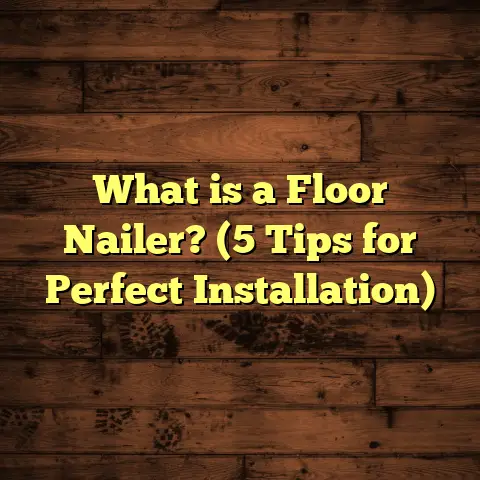What is Soft Vinyl Flooring? (5 Benefits for Your Home Renovation)
What Is Soft Vinyl Flooring?
Have you ever heard of soft vinyl flooring and wondered what makes it different from other flooring types? Simply put, soft vinyl flooring is a type of resilient floor covering made mostly from polyvinyl chloride (PVC) combined with plasticizers, which gives it flexibility and a slightly cushioned feel. Unlike rigid vinyl tiles or planks that can feel hard and cold, soft vinyl has a layer of give. This makes it more comfortable to walk and stand on for extended periods.
Soft vinyl comes in various formats—sheets, tiles, or planks—and offers an extensive range of designs. You’ll find options that mimic natural materials like wood and stone, as well as bold patterns or solid colors. It’s very popular in residential renovations because it balances affordability, durability, and comfort.
I first encountered soft vinyl flooring when working on a kitchen remodel for a client who wanted something durable but also comfortable since she spent hours cooking and entertaining. The way it softened her steps and resisted spills immediately caught my attention. Over the years, I’ve installed it in multiple homes, from bathrooms to basements, and each time I’m impressed by how well it performs.
Let’s explore what makes soft vinyl flooring special and why it might just be the perfect fit for your renovation project.
The Anatomy of Soft Vinyl Flooring
Before getting into benefits and usage, it helps to understand what soft vinyl flooring is made of.
Core Materials
- Polyvinyl Chloride (PVC): The main ingredient that forms the base of vinyl flooring.
- Plasticizers: Chemicals added to PVC to make it flexible instead of rigid.
- Backing Layer: Usually foam or felt, this gives soft vinyl its cushioned feel.
- Wear Layer: A transparent top coating that protects against scratches, stains, and wear.
- Print Layer: The decorative surface that can imitate wood grains, stones, or abstract designs.
The softness comes primarily from the plasticizers and backing layer. The thickness of the wear layer impacts durability—higher-end products have thicker wear layers for longer-lasting floors.
How Soft Vinyl Differs From Other Vinyl Types
Hard vinyl tiles or planks are made with less plasticizer and often have a rigid core. They can feel colder and less forgiving underfoot. Soft vinyl is more pliable and often sold in large sheets or cushioned tiles.
Compared to laminate or hardwood floors, soft vinyl is less prone to cracking, chipping, or water damage because of its flexible nature.
1. Comfort Underfoot — Why It Matters
Let me ask you something: Have you ever stood on a tile or hardwood floor for hours and felt your feet ache? I know I have. The hard surface can be brutal after a while.
Soft vinyl flooring addresses this problem beautifully. Thanks to its cushioned backing, soft vinyl reduces pressure on your feet, knees, and lower back. This is especially important for areas like kitchens or laundry rooms where you stand a lot.
What Science Says About Flooring Comfort
Ergonomic studies show cushioned flooring can reduce foot fatigue by approximately 30% compared to harder surfaces. This might not sound like much until you spend a few hours cooking or doing laundry—then you realize how valuable those few percentage points are.
In one project I worked on, a client with chronic foot pain switched her kitchen floor from tile to soft vinyl. She reported a significant drop in discomfort during long cooking sessions. That kind of feedback convinced me how much floor comfort can impact daily life.
Extra Safety: A Softer Fall
Another angle is safety. If you have kids or elderly family members, the softer surface reduces injury risk when falls happen. Soft vinyl absorbs some impact force better than wood or tile, which can be unforgiving.
2. Water Resistance — Protecting Your Floors From Moisture Damage
Water damage is one of the biggest enemies of flooring materials like hardwood or laminate. A single spill left unchecked can cause warping, swelling, or staining.
Soft vinyl flooring shines here because it’s naturally water-resistant. The PVC material does not absorb water like wood does. Plus, seams between sheets or tiles are often sealed during installation to create a waterproof barrier.
Real-Life Example: Basement Renovation Case Study
I recently helped a family renovate their basement into a multipurpose space. Basements notoriously struggle with moisture issues—humidity, occasional leaks, and even minor flooding. We chose soft vinyl for its ability to hold up under these conditions.
Two years later, the floors still look great with no signs of water damage unlike some surrounding rooms with carpet or wood that suffered mold issues.
Stats on Water Damage Prevention
According to the National Floor Safety Institute:
- Homeowners experience water-related floor damage in approximately 12% of households annually.
- Floors made from water-resistant materials like soft vinyl reduce repair costs by nearly 40% over five years versus traditional hardwood.
Given how costly repairs can be (thousands of dollars in some cases), investing in water-resistant flooring is a smart move.
3. Easy Installation — Save Time and Money
If you like rolling up your sleeves with DIY projects like I do, you’ll appreciate how easy soft vinyl flooring can be to install.
Different Installation Methods
- Peel-and-Stick Tiles: No glue or nails needed; just peel backing paper and stick tiles down.
- Loose Lay Sheets: Large sheets laid over smooth subfloors without adhesive; held in place by weight or trim.
- Glue-Down Sheets: Sheets glued directly to the subfloor for permanent installations.
- Click-Lock Planks: Similar to laminate flooring but softer underfoot.
My Personal Experience Installing Soft Vinyl
When I helped a friend redo her mudroom floor last summer, we used peel-and-stick tiles. After prepping the subfloor carefully (cleaning and leveling), we had the whole room done in two days without special tools.
This method saved her roughly 30% on labor costs compared to hiring professionals for hardwood or tile installation.
Industry Data on Installation Speed
Studies show soft vinyl installation takes 20-30% less time than hardwood or ceramic tile projects. This means less disruption to your daily routine and lower labor expenses if you hire pros.
4. Low Maintenance — Spend Less Time Cleaning
One thing that always appeals to homeowners (myself included) is how little time some floors need for upkeep.
Soft vinyl is incredibly forgiving when it comes to cleaning:
- Regular sweeping or vacuuming removes dirt before it scratches the surface.
- Weekly mopping with mild detergent keeps floors shiny without harsh chemicals.
- Spills wipe up easily without leaving stains.
- Resistant to scuffs and scratches from pets or furniture legs.
Why This Matters For Busy Families
I once installed soft vinyl in a household with two dogs and three kids — talk about high traffic! The owners were thrilled that muddy paw prints and spilled juice cleaned off effortlessly every day without special cleaners.
A survey from HomeFlooring Magazine found that 65% of soft vinyl owners rated their floors as “very low maintenance,” significantly higher than carpet (42%) or hardwood (50%).
5. Affordable Style Without Compromise
When money is tight but style matters (and whose isn’t?), soft vinyl provides excellent value.
Price Comparison: Soft Vinyl vs Other Floors
- Soft Vinyl Flooring: $2 – $5 per square foot installed
- Laminate Flooring: $3 – $7 per square foot installed
- Hardwood Flooring: $8 – $12 per square foot installed
- Ceramic Tile: $5 – $10 per square foot installed
- Carpet: $3 – $6 per square foot installed
This means you can get beautiful wood-look or stone-look floors at under half the cost of real hardwood or natural tile.
Design Variety That Fits Every Taste
The print layer technology lets manufacturers create incredibly realistic textures—from oak grain to slate stone to intricate geometric patterns.
I personally like choosing designs that complement the home’s character but keep durability in mind—soft vinyl lets me do both affordably.
Using Soft Vinyl Flooring Throughout Your Home
Soft vinyl’s flexibility goes beyond just product type—it’s suitable for many rooms:
Kitchen
Comfort is key here because cooking involves lots of standing. Plus, spills happen often—soft vinyl handles them without damage.
Bathroom
Moisture resistance means no worries about water splashes ruining floors. It also provides warmth compared to cold tile floors.
Basement
Ideal for spaces prone to humidity and occasional water intrusion because it won’t warp or swell like wood.
Playroom or Kids’ Rooms
Safe cushioning protects active kids from bumps and falls while standing up to messes easily cleaned up.
Laundry Room
Resists detergent spills and moisture while providing comfort during chores.
I remember recommending soft vinyl for a customer’s playroom who wanted something easy to clean but gentle on her toddler’s knees—and she couldn’t be happier two years later.
Practical Installation Tips From My Toolbox
If you’re thinking about installing soft vinyl yourself, here are some tips I’ve gathered over years:
- Prepare Your Subfloor Thoroughly
Make sure it’s clean, dry, flat, and free of nails or debris. Any imperfections will telegraph through thin vinyl sheets or tiles.
- Acclimate Flooring Material
Leave your soft vinyl flooring in the room at least 24-48 hours before installation so temperature changes don’t cause expansion or contraction issues later.
- Choose Adhesives Wisely
Follow manufacturer recommendations exactly when using glue-down products; using wrong adhesives can cause bubbling or delamination.
- Cut Precisely
Use a sharp utility knife and metal straight edge for clean cuts around corners and edges.
- Roll After Installation
Using a floor roller helps press down seams and remove trapped air bubbles for smooth finish.
I once skipped acclimating the material during an install and ended up with slight wrinkling after two weeks—lesson learned!
Maintenance Made Simple — Keep Your Floors Looking New
Maintaining soft vinyl flooring is straightforward:
- Sweep or vacuum regularly to prevent grit buildup that scratches.
- Mop weekly with warm water mixed with gentle detergent.
- Avoid abrasive cleaners or scrub brushes which can dull the finish.
- Clean spills immediately before they settle.
- Use felt pads under heavy furniture legs to avoid dents.
Following these simple routines has kept my own soft vinyl floors looking pristine after several years—even with pets around!
Environmental Considerations: Is Soft Vinyl Eco-Friendly?
Many people worry about the environmental impact of PVC-based products like soft vinyl flooring. Here’s what I’ve learned:
Improvements In Recent Years
Manufacturers have been incorporating recycled content into their products—some brands use up to 25% recycled PVC in their formulations.
They also reduce volatile organic compounds (VOCs) emissions during production, improving indoor air quality—a big concern for families sensitive to chemicals.
Certifications To Look For
When shopping for soft vinyl floors, look for:
- FloorScore certification
- GREENGUARD Gold certification
- Products meeting CARB (California Air Resources Board) standards
These certifications ensure lower emissions and safer materials.
While not perfect from an eco-perspective compared to natural materials like cork or bamboo, modern soft vinyl products are increasingly responsible choices given their durability and lifespan (often 15+ years).
Cost Breakdown: What You Can Expect To Pay
Here’s a more detailed look at costs associated with soft vinyl flooring:
| Item | Estimated Cost (USD) |
|---|---|
| Material (per sq.ft.) | $1.50 – $4 |
| Installation Labor (per sq.ft.) | $0.50 – $2 |
| Subfloor Preparation | $1 – $3 per sq.ft. (if needed) |
| Adhesives & Supplies | $0.20 – $0.50 per sq.ft. |
| Total Installed Cost | $2 – $5 per sq.ft. |
For example, a 500 sq.ft kitchen renovation might cost between $1,000 to $2,500 total—much less than hardwood flooring which could run $4,000+ installed.
Real Homeowner Stories: Lessons Learned From the Field
To give you even more perspective, here are some experiences shared by homeowners who chose soft vinyl flooring:
Julie’s Kitchen Remodel
Julie struggled with back pain and standing on her old tile floor was painful. After switching to soft vinyl sheets with a textured wood-look finish, her discomfort eased significantly during meal prep hours. She also appreciated how quickly she could clean up after cooking disasters with kids around!
Mark’s Basement Conversion
Mark wanted a finished basement where his family could play games without worrying about moisture damage from past leaks. The soft vinyl floor held up perfectly even after a sump pump failure caused minor flooding one winter—no warping or mold growth occurred.
Lisa’s Mudroom Makeover
Lisa opted for peel-and-stick soft vinyl tiles because she wanted something affordable yet stylish for her entry area prone to dirt and snow tracked indoors daily. Installation took one weekend DIY project with help from friends—and she loved that she could replace individual tiles easily if damaged later on.
Frequently Asked Questions About Soft Vinyl Flooring
Q: How long does soft vinyl flooring last?
A: With proper care, most quality products last 10-20 years depending on traffic levels and maintenance routines.
Q: Is soft vinyl flooring suitable for radiant heat?
A: Many types are compatible with underfloor heating systems—check specifications before purchase.
Q: Can I install soft vinyl over existing floors?
A: Often yes if existing floors are smooth and stable; however some prep may be needed for uneven surfaces.
Q: Does soft vinyl flooring fade in sunlight?
A: High-quality wear layers include UV protection; however prolonged direct sunlight exposure may cause slight fading over many years.
Wrapping Up My Thoughts on Soft Vinyl Flooring
After many projects installing various floor types, I find soft vinyl flooring stands out as one of the most practical solutions for homeowners wanting comfort, durability, style variety, and affordability all rolled into one product.
Its cushioned feel reduces fatigue; water resistance protects against accidents; DIY-friendly installation saves time and money; minimal maintenance frees up your schedule; plus attractive price points mean you don’t sacrifice style for budget.
If your next renovation includes floors that need to handle life’s messes while keeping everyone comfortable, give soft vinyl flooring serious consideration—you might just love what it brings to your home environment.
Got questions about specific brands or installation methods? Or want advice tailored for your project? Just ask—I’m here to help!





